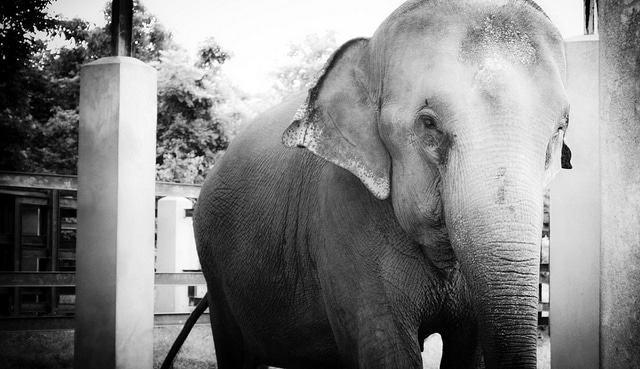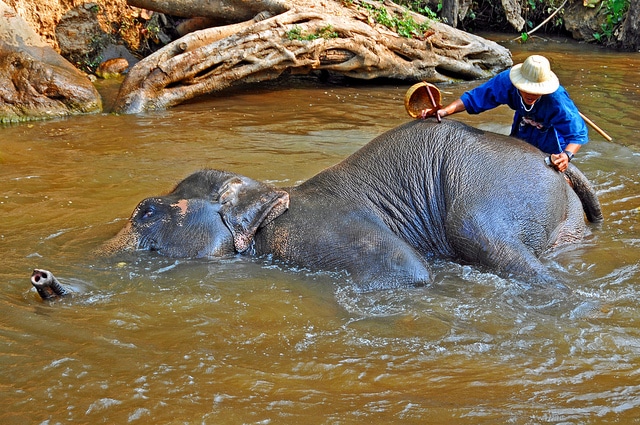
Asian elephant. Photo courtesy of manuelsvay.
To most tourists, a trip to Thailand isn’t complete without crystalline beaches, a wild night in Bangkok, some delicious Pad Thai and a jungle trek on the back of an elephant. While these activities sound like the making of a perfect vacation, in the case of elephant riding, the ends to the experience don’t exactly justify the means.
About Asian Elephants
Known as a gentle giant, Asian elephants are slightly smaller than their African relatives and have a friendly and social nature. Currently endangered, their population sits between 25,000 – 33,000. A century ago, the population was closer to 300,000 and with humans as their only serious threats, numbers have dwindled significantly due to hunting (for their ivory tusks) and animals being captured and used for manual labor.
Before 1989, the main use of these animals across Southeast Asia was to carry timber for logging industries; however, in 1989 the Asia-Pacific Forestry Commission put strict regulations on the industry, effectively banning logging from numerous countries. As a result, many elephants were put out of work. Some continued to work in illegal logging operations, however, many were killed or crippled by landmines put in place to cease illegal logging. Others were traded into the tourism industry and put to work performing in circuses and trekking tourists through jungle tours. While this fate may seem better than working in the logging industry, life for elephants working in tourism was often equally bleak.
Current Conditions For Thai Elephants
In Thailand, the wild elephant population currently sits around 1,500 and as an engendered species, they are safeguarded under the Wildlife Protection Act from hunting and domestication. Many of these elephants also live in national parks and wildlife sanctuaries where they are further protected; however, due to the extent of (sometimes illegal) elephant tourism in Thailand, it has been estimated that around 2,000 elephants are held in captivity to work in the Thai tourism industry. As a result of being considered domesticated animals, they are not included in the Wildlife Protection Act.
In order for Mahouts (or trainers) to obtain an elephant for their tour operation, many rely on imports from Myanmar, where 5,000 wild elephants live in less regulated conditions. From here, baby elephants are captured and taken from their herd and smuggled across the Thai border. Mother elephants are very protective of their young and as a result, for each elephant capture, around five female and adolescent elephants are gunned and killed before a calf can be captured. As the captured elephants are young and impressionable, they are more reactive to the torturous ritual known as Phajaan.
This consists of the elephant being tied up, starved and beaten so that they associate disobeying humans with pain. With this, few of the calves even make the journey to Thailand, with many dying from stress, starvation and depression. Those that do survive are chained to an already domesticated mother. As domestic elephant births do not need to be recorded until the animal reaches eight years of age, it makes it easy to sneak a new animal into the country. Once registered, these baby elephants can be worth up to $33,000 USD.
As an elephant is sold into the tourism industry, many end up working to transport tourists on elephant trekking voyages. Here, elephants often walk for long hours carrying heavy, uncomfortable loads. The trekking typically causes blisters and joint problems in the elephants’ feet and many are unable to slow down and rest for fear of getting prodded with a bullhook by guides. The chairs that are placed on their backs also cause blisters and the excessive weight can lead to long-term spinal injuries. When not working, elephants are kept in small pens and are rarely able to interact with other elephants. As social creatures, this can lead to emotional issues for the animals.

Bathing an elephant. Photo courtesy of archer10 (Dennis)
Choosing A Sustainable Elephant Tour
While it is nearly impossible to determine which elephants have been illegally imported, there are a few telltale signs for determining whether an elephant tourism establishment practices fair treatment:
- You’re allowed to interact with the elephant: If you’re simply going to be loaded onto the animal’s back in a chair without much interaction, it’s probably to hide the fact the animal is not friendly and in good spirits. Generally, if you’re given the opportunity to bathe the elephants, you’ll get plenty of opportunity to interact with them up close.
- You’re not given a ride in a chair on the elephant’s back: Many ethical companies won’t allow elephant riding, as it harms the animal. Instead, they may offer the opportunity to walk alongside the elephants. If you still really want to ride an elephant, look for places that will teach visitors to ride an elephant bare-back as this causes significantly less harm to the animal.
- General behavior of the animals: Mistreated elephants tend to sway, bob their heads and pace back and forth as signs of stress.
A few reputable elephant tour companies in Thailand include:
Thai Elephant Conservation Center
Overview: a government owned camp, which teaches visitors how to properly interact with elephants. They also operate and on-site elephant hospital
Location: Lampang
Website: http://www.thailandelephant.org/en/
Boon Lott’s Elephant Sanctuary
Overview: a homestay experience where visitors help bathe elephants and walk them to release sites as well as gather their food and perform secondary duty with the local community
Location: Baan Tuel
Website: http://www.blesele.org/
Elephant Nature Park
Overview: an elephant rehabilitation center geared towards educating visitors.
Location: near Chiang Mai
Website: http://www.elephantnaturepark.org/
Contributed by guest author Judi Zienchuk.

Jessica Festa is the editor of the travel sites Jessie on a Journey (http://jessieonajourney.com) and Epicure & Culture (http://epicureandculture.com). Along with blogging at We Blog The World, her byline has appeared in publications like Huffington Post, Gadling, Fodor’s, Travel + Escape, Matador, Viator, The Culture-Ist and many others. After getting her BA/MA in Communication from the State University of New York at Albany, she realized she wasn’t really to stop backpacking and made travel her full time job. Some of her most memorable experiences include studying abroad in Sydney, teaching English in Thailand, doing orphanage work in Ghana, hiking her way through South America and traveling solo through Europe. She has a passion for backpacking, adventure, hiking, wine and getting off the beaten path.








